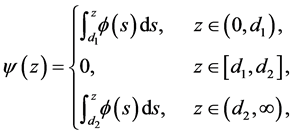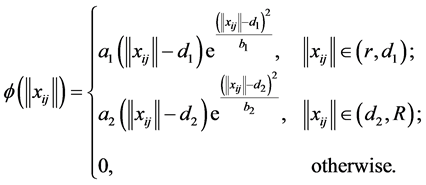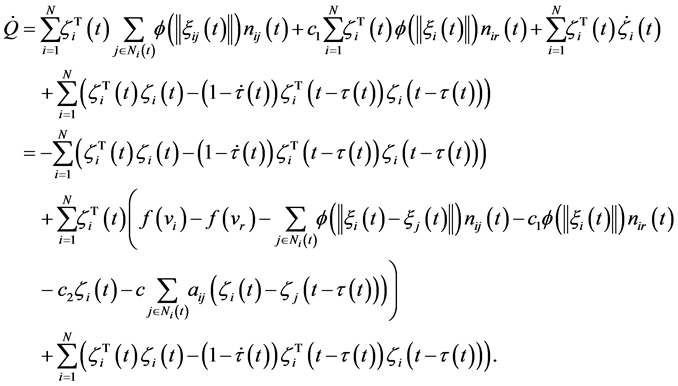Intelligent Control and Automation
Vol.07 No.01(2016), Article ID:63383,7 pages
10.4236/ica.2016.71002
Flocking for Leader-Following Multi-Agent Systems with Time-Varying Delay
Fenglan Sun1, Rui Wang1, Yongfu Li2, Feng Liu3
1Research Center of System Theory and Application, Chongqing University of Posts and Telecommunications, Chongqing, China
2College of Automation, Chongqing University of Posts and Telecommunications, Chongqing, China
3School of Automation, China University of Geosciences, Wuhan, China

Copyright © 2016 by authors and Scientific Research Publishing Inc.
This work is licensed under the Creative Commons Attribution International License (CC BY).
http://creativecommons.org/licenses/by/4.0/



Received 28 November 2015; accepted 3 February 2016; published 6 February 2016
ABSTRACT
This paper investigates the flocking problem in multi-agent system with time-varying delay and a virtual leader. Each agent here is subject to nonlinear dynamics. For the system, the corresponding algorithm with time-varying delay is proposed. Under the assumption that the initial network is connected, it is proved that the distance between agents is in the desired distance. The theore- tical deduction shows that the stable flocking motion is achieved.
Keywords:
Flocking, Time-Varying Delay, Nonlinear Dynamics, Multi-Agent System, Virtual Leader

1. Introduction
Flocking is a collective behavior of large number of interacting agents with a common group objective. Examples of these agents include birds, fish, penguins, ants, bees, and crowds. Many scientists from rather diverse disciplines, including physics, mathematics, control engineering and biology, have been interested in flocking problem [1] -[8] . The first well-known flocking model was proposed by Craig Reynolds [2] . Reynolds started with a boid model to build a simulated flock and introduced three rules (i.e., separation, cohesion and alignment rules) for flocking. Based on Reynolds’ three rules, flocking problems have been investigated from various perspectives [9] -[15] . In [16] , an artificial potential function is put forward and three algorithms are introduced. It provides a theoretical framework for the designing of flocking algorithms. Multi-agent flocking under topological interactions is considered, which define a notion of hierarchical structure in the interaction graph that establish conditions building upon previous work on multi-agent systems with switching communication networks in [17] . Using structurally balanced signed graph theory and a specified potential function, a stable bipartite flock formation is achieved for both virtual leader and leaderless situations in [18] . However, there is a common assumption that virtual leaders guide the flocking behaviors of the group. In this paper, leader follower flocking problem of multi-agent system is considered.
A flocking problem concerning multiple leaders in which followers use the position of flocking center to keep their connections is studied in [19] . In [20] , two leader-follower adaptive flocking algorithms are proposed with the combination of consensus and attraction/repulsion function respectively to solve the cohesive flocking problem and the formation flocking problem. Aiming at the group of autonomous agents consisting of multiple leader agents and multiple follower ones, a flocking behavior method with multiple leaders and a global trajectory was proposed in [21] . Yu et al., [22] give a distributed leader-follower algorithm considering the group consisting of one leader. In [23] , for the circumstance with a virtual leader, the agents would follow the virtual leader and achieve the same velocity asymptotically.
In practice, time delay is inevitable and would damage the stability of system. Jing et al. [23] investigate flocking problem of multi-agent systems with time delay and discuss systems with homogeneous and inhomogeneous time delay. Yang et al. [24] proposed an adaptive flocking algorithm for multi-agent system with time delay. It is proved that the distance between agents can be larger than a constant during the motion evolution by using the flocking algorithm. The authors investigate the flocking problem of multi-agent systems led by one active virtual leader with a directed topology containing time-varying coupling delays, which based only on the three classical assumptions for flocking systems in [25] . Because of these problems, this paper will study the flocking problems in the multi-agent system with a virtual leader and time-varying delay.
The rest of this paper is organized as follows. Some basic preliminaries and flocking algorithms are presented in Section 2. Section 3 gives the nonlinear leader-following multi-agent models. Algorithms and main results are presented in Section 4. Section 5 concludes the paper and offers suggestions for future work.
2. Preliminaries
In this section, some related preliminary knowledge are introduced. For any vector  denotes its transpose and
denotes its transpose and  denotes the Euclidean norm. Let
denotes the Euclidean norm. Let  be a weighted undirected graph with the set of nodes
be a weighted undirected graph with the set of nodes  and the set of agents
and the set of agents 
Graphs with self-loops will not be considered in this paper. The weight adjacency matrix  where
where  if
if  otherwise,
otherwise,  An edge denoted by the pair
An edge denoted by the pair  represents a commu- nication link from node j to i. A path
represents a commu- nication link from node j to i. A path  from node i to node j is a sequence of edges,
from node i to node j is a sequence of edges,  in which all nodes
in which all nodes  are distinct. An undirected graph is called connected if there is a path between each pair of distinct nodes.
are distinct. An undirected graph is called connected if there is a path between each pair of distinct nodes.  is the degree matrix whose diagonal elements are defined by
is the degree matrix whose diagonal elements are defined by  The Laplacian matrix of graph
The Laplacian matrix of graph 

1) The eigenvalues of L satisfy 

2) The Laplacian matrix L is a positive semi-definite matrix that satisfies the following sum-of-squares property:
Lemma 1. [4] Suppose that 







Lemma 2. For any vectors 
3. Problems Formulation
Consider the multi-agent system described by

where 



For the systems with virtual leader available, the dynamics of virtual leader is described as

where 
Assumption (A): There exists a positive constant 

Supposed that all agents have the same sensing radius 

Definition 1: Given a constant


1) Initial links are generated by
2) If 




3) If 

The neighboring set of agent i is divided into four regions, named collision region, separation region, alignment region and attraction region, in which 

Definition 2. 

1) 
2) 
3) 
Definition 3. The pairwise bounded potential function 

which satisfies
1) 

2) 


According to conditions, 
where the parameters 

4. Algorithms and Main Results
For system (1) with virtual leader (2), the flocking algorithm can be described by

where 


The control input (6) can be equivalently rewritten as

Denote
Definition 4. Flocking motion with a virtual leader is said to be achieved asymptotically for systems (1) and (2), if for any initial state, there is


To demonstrate the validity of control protocol (7), the following positive semi-definite function is constructed

where
Theorem 1. Consider a multi-agent system modeled by dynamics (1) and (2), driven by control protocol (5). Suppose that the network is initially connected and 

1) 

2) No collision occurs among agents for all
3) Flocking motion with a virtual leader is achieved asymptotically.
Proof: Denote the topology switching time sequence as 


From Lemma 2, there is
For a positive constant k, one has
Assume that 


which implies that
By definition (2), one has






Hence there is no edge lost. In addition, from the definite of potential function, one has

Similar to the above analysis, taking the time derivative of 

one has








Similarly, from








is positively invariant, where
and
Since 




has

principle that if the initial condition lies in Ω, then the corresponding trajectories will converge to the largest invariant set inside the region
From (8), 

Since


Thus, unless the inital configuration of the agents is close enough to the global minimum, almost every final configuration locally minimizes each agent’s global potential. which implies
Then the flocking is achieved. This completes the proof of part (3), thus Theorem 1 hold.
Remark 1. If 
5. Conclusion
This paper mainly discusses the flocking problem of multi-agent system with a virtual leader and time-varying delay. Unlike most existing flocking algorithms, each agent here is subject to nonlinear dynamics. The corresponding algorithms with the time-varying delay are proposed. Under the assumption that the initial network is connected, the theoretical deduction is made. The related topic over the directed network or the jointly connected network will be studied in future.
Acknowledgements
We thank the Editor and the referee for their comments. This work was supported by the National Nature Sci- ence Foundation of China under Grants 61503053, 61472374 and 61304197, the Natural Science Foundation Pro- ject of CQ CSTC, China (Grant No. cstc2013jcyjA40018), the Youth Science Research Project of CQUPT, China (Grant Nos. A2012-78 and A2012-82), the Doctor Start-up Foundation of CQUPT, China (Grant Nos. A2012-23 and A2012-26), the Natural Science Fundation of CQJW, China (Grant Nos. KJ130506 and KJ1400435), and Training Programme Foundation for the Talents of Higher Education Commission. This support is greatly appreciated.
Cite this paper
FenglanSun,RuiWang,YongfuLi,FengLiu, (2016) Flocking for Leader-Following Multi-Agent Systems with Time-Varying Delay. Intelligent Control and Automation,07,9-15. doi: 10.4236/ica.2016.71002
References
- 1. Toner, J. and Tu, Y. (1998) Flocks, Herds, and Schools: A Quantitative Theory of Flocking. Physical Review E, 58, 4828.
http://dx.doi.org/10.1103/PhysRevE.58.4828 - 2. Reynolds, C.W. (1987) Flocks, Herds and Schools: A Distributed Behavioral Model. ACM Siggraph Computer Graphics, 21, 25-34.
http://dx.doi.org/10.1145/37402.37406 - 3. Toner, J. and Tu, Y. (2005) Hydrodynamics and Phases of Flocks. Annals of Physics, 318, 170-244.
http://dx.doi.org/10.1016/j.aop.2005.04.011 - 4. Olfati-Saber, R. (2006) Flocking for Multi-Agents with a Virtual Leader. IEEE Transactions on Automatic Control, 51, 410-420.
- 5. Crowther, B. (2002) Flocking of Autonomous Unmanned Air Vehicles. Aeronautical Journal, 107, 99-109.
- 6. Akyildiz, I.F., Su, W. and Cayirci, E. (2002) A Survey on Sensor Networks. IEEE Communications Magazine, 40, 102-114.
http://dx.doi.org/10.1109/MCOM.2002.1024422 - 7. Partridge, B.L. (1984) The Chorus-Line Hypothesis of Maneuver in Avian Flocks. Nature, 309, 344-345.
- 8. Gazi, V. and Passino, K.M. (2004) Stability Analysis of Social Foraging Swarms. IEEE Transactions on Systems, Man, and Cybernetics, Part B: Cybernetics, 34, 539-557.
http://dx.doi.org/10.1109/TSMCB.2003.817077 - 9. Ren, W. and Atkins, E. (2007) Distributed Multi-Vehicle Coordinated Control via Local Information Exchange. International Journal of Robust and Nonlinear Control, 17, 1002-1033.
http://dx.doi.org/10.1002/rnc.1147 - 10. Tanner, H.G., Jadbabaie, A. and Pappas, G.J. (2007) Flocking in Fixed and Switching Networks. IEEE Transactions on Automatic Control, 52, 863-868.
http://dx.doi.org/10.1109/TAC.2007.895948 - 11. Su, H., Wang, X. and Lin, Z. (2009) Flocking of Multi-Agents with a Virtual Leader. IEEE Transactions on Automatic Control, 54, 293-307.
http://dx.doi.org/10.1109/TAC.2008.2010897 - 12. Topaz, C.M. and Bertozzi, A.L. (2004) Swarming Patterns in a Two-Dimensional Kinematic Model for Biological Groups. SIAM Journal on Applied Mathematics, 65, 152-174.
http://dx.doi.org/10.1137/S0036139903437424 - 13. Chen, Z. and Zhang, H.T. (2013) A Remark on Collective Circular Motion of Heterogeneous Multi-Agents. Automatica, 49, 1236-1241.
http://dx.doi.org/10.1016/j.automatica.2013.01.017 - 14. Zhang, H.T., Zhai, C. and Chen, Z. (2011) A General Alignment Repulsion Algorithm for Flocking of Multi-Agent Systems. IEEE Transactions on Automatic Control, 56, 430-445.
http://dx.doi.org/10.1109/TAC.2010.2089652 - 15. Lu, X.Q., Austin, F. and Chen, S.H. (2011) Flocking in Multi-Agent Systems with Active Virtual Leader and Time-Varying Delays Coupling. Communications in Nonlinear Science and Numerical Simulation, 16, 1014-1026.
http://dx.doi.org/10.1016/j.cnsns.2010.05.004 - 16. Olfati-Saber, R. (2006) Flocking for Multi-Agent Dynamic Systems: Algorithms and Theory. IEEE Transactions on Automatic Control, 51, 401-420.
http://dx.doi.org/10.1109/TAC.2005.864190 - 17. Martin, S. (2014) Multi-Agent Flocking under Topological Interactions. Systems and Control Letters, 69, 53-61.
http://dx.doi.org/10.1016/j.sysconle.2014.04.004 - 18. Fan, M.C., Zhang, H.T. and Wang, M. (2014) Bipartite Flocking for Multi-Agent Systems. Communications in Nonlinear Science and Numerical Simulation, 19, 3313-3322.
http://dx.doi.org/10.1016/j.cnsns.2013.10.009 - 19. Gu, D. and Wang, Z. (2009) Leader-Follower Flocking: Algorithms and Experiments. IEEE Transactions on Control Systems Technology, 17, 1211-1219.
- 20. Jia, Y. and Zhang, W. (2014) Distributed Adaptive Flocking of Robotic Fish System with a Leader of Bounded Unknown Input. International Journal of Control, Automation and Systems, 12, 1049-1058.
http://dx.doi.org/10.1007/s12555-013-0518-6 - 21. Li, M., Liang, J. and Li, S. (2014) Flocking Behavior with Multiple Leaders and Global Trajectory. Journal of Central South University, 21, 2324-2333.
http://dx.doi.org/10.1007/s11771-014-2184-0 - 22. Yu, W., Chen, G. and Cao, M. (2010) Distributed Leader-Follower Flocking Control for Multi-Agent Dynamical Systems with Time-Varying Velocities. Systems & Control Letters, 59, 543-552.
http://dx.doi.org/10.1016/j.sysconle.2010.06.014 - 23. Luo, J., Zhang, S., Kang, H., et al. (2013) Flocking Algorithms for Multi-Agent Systems with Time-Delay. Proceedings of the IEEE International Workshop on Microwave and Millimeter Wave Circuits and System Technology (MMWCST), Chengdu, 24-25 October 2013, 428-431.
- 24. Yang, Z., Zhang, Q. and Chen, Z. (2013) A Novel Adaptive Flocking Algorithm for Multi-Agents System with Time Delay and Nonlinear Dynamics. Proceedings of the 32nd IEEE Chinese Control Conference (CCC), Xi’an, 26-28 July 2013, 998-1001.
- 25. Lu, X., Austin, F. and Chen, S. (2011) Flocking in Multi-Agent Systems with Active Virtual Leader and Time-Varying Delays Coupling. Communications in Nonlinear Science and Numerical Simulation, 16, 1014-1026.
http://dx.doi.org/10.1016/j.cnsns.2010.05.004 - 26. Shi, H., Wang, L. and Chu, T. (2006) Virtual Leader Approach to Coordinated Control of Multiple Mobile Agents with Asymmetric Interactions. Physica D: Nonlinear Phenomena, 213, 51-65.
http://dx.doi.org/10.1016/j.physd.2005.10.012
























